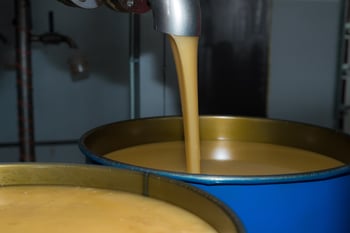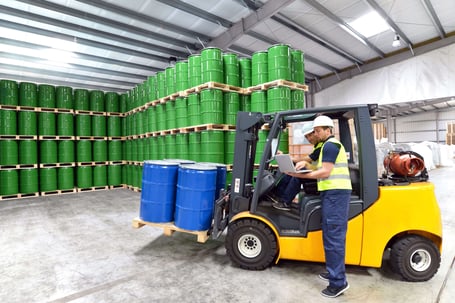Managing spill risk is an essential requirement under Australian Work Health and Safety Regulations. Your workplace must have effective measures in place that will contain any possible chemical leaks and the resulting effluent. But before you can put these risk control measures in place, you’ll need to first identify the spill risk associated with your Class 3 Flammable Liquids. In this blog, we’ll take you step-by-step through the key considerations of your spill risk assessment, so you can reduce the hazards that are involved with storing flammable liquids at your worksite.
1. Identifying Spill Hazards
The first step in a chemical spill risk assessment is to identify every location on the worksite where flammable liquids are kept.
This usually requires a physical walk around the site — taking note of chemicals stores and observing workers who use flammable liquids. Your notes will detail any spill hazards you have identified.
Some examples of potential spill hazards in the workplace may include:
- Loading dock - how could chemicals spill as they are being delivered to the site and unloaded?
- Chemical stores - are chemical stores protected from impact? Are the chemicals stored inside liquid tight flammable cabinets? Do staff put the chemicals away promptly? Do flammable liquid containers have secure lids in place?
- Warehouse - do chemicals stored on pallets have sufficient bunding? Are pallets overloaded? Are workers using correct lifting aids to move chemicals?
- Decanting station - are workers using safe work practices that minimise splashing and over pouring of chemicals? Are decanting stations protected with bunds and spill trays?
- Internal transfer - how are chemicals transferred between departments? Are correct manual handling practices employed? Do you use drum caddies or dollys?
- Workstations - do workers keep chemicals out on work benches? Do workers keep chemicals on trays when on the job? Do workers hand pour when fuelling machines and compressors?
- Waste handling - are waste chemicals isolated on bunded pallets and removed promptly?
- Miscellaneous - are there any chemicals onsite that have no spill protection (even temporary areas)?

If your workers are decanting flammable liquids, you must identify any unsafe work practices and ensure decanting stations are equipped with spill trays and bunds.
2. Assessing Physical, Health and Environmental Risks
Once you have a list of all the spill hazards in your workplace, you’ll need to assess the risk that a chemical spill presents to the health and safety of your workers, your property and the environment.
Fires, Explosions, Chemical Reactions
When flammable liquids are spilt, they can travel quickly throughout a workplace. In fact, Class 3 Flammable Liquids have been known to rapidly spread through additional work areas, down flights of stairs and even under closed doors.
If these dangerous chemicals come near an ignition source, they can quickly ignite and cause a raging fire to travel quickly throughout the workplace. Therefore, a crucial part of your risk assessment should be considering the possibility of fire, explosion and chemical reaction.
You may wish to consider the likelihood of the flammable chemicals igniting. You should also consider that if they did, how far could that fire spread throughout your organisation? What circumstances would create the opportunity for explosion? And could the chemical spill come into contact with incompatible substances?
To determine the risk of fire, explosion and chemical reactions, you’ll need to know:
- The flash point and autoignition temperature of the chemicals
- Any potential ignition sources that are in the area
- What could cause the chemicals to explode or react dangerously?
- Could the stability of incompatible chemicals or substances be compromised during a spill?
- What is the accessibility of fire equipment and spill kits?
- What is the fire risk during response, clean-up and disposal?
REMEMBER: Flammable liquid spills can soak into clothing, rags, cardboard cartons, wood, dust and dirt — and still remain flammable. Your emergency response needs to consider the safe clean-up and disposal of all items that have been contaminated by the chemical spill.
Health Risks
Even if the Class 3 Flammable Liquids don’t ignite, they can still create dangerous health risks for workers in the area — including the clean-up crew.
When considering the health risks associated with chemical spills, think about:
- Acute health effects — can the flammable chemicals cause immediate skin burns, eye damage, throat irritation, dizziness, nausea, impairment or even death?
- Chronic health conditions — could workers responding to a chemical spill be exposed long enough to develop long term health affects like asthma, respiratory problems or cancer?
Environmental Risks
If spilled flammable liquids penetrated workplace drains or soil, what is the potential for damage? Your risk assessment should include all environmental hazards that could occur if chemicals spilled out into the environment.
Ask yourself: Could the chemicals contaminate groundwater or pastoral lands? Could plants be harmed in native forests or public gardens? Would a chemical spill threaten the lives of animals and native fauna?
REMEMBER: Class 3 Flammable Liquids cabinets provide excellent spill protection as each cabinet has a liquid-tight spill containment sump based on the capacity rating of the cabinet.
3. Determining Risk Severity
The next step in your risk assessment should be to determine the risk severity. Put simply, risk severity is the actual risk a chemical spill would cause for your business.
To determine the risk severity, you will be looking at a combination of:
- Outcomes - if the chemicals did spill what would be the results? Eg, major fire, loss of property, multiple fatalities and injuries vs minor skin irritation, 30 minutes lost work time.
- Likelihood - how often are the chemicals used, handled? Eg, chemicals sitting permanently on the ground without bunding vs chemicals left overnight before being put away.
- Quantity - larger quantities of chemicals increase the risk severity. Eg, a jerry can of mower fuel spilling vs 10,000 litres of petrol.
- Toxicity - how toxic are the chemicals? Eg, a large spill of benzene that can contaminate groundwater vs diesel fuel splashing while decanting.
- X-factor - is there anything about your worksite that increases the risk severity? Eg, proximity to native forests.
The hazards that present the greatest risk to your business are the ones that (potentially) have the most catastrophic outcomes — and are the most likely to occur.
4. Creating An Action Plan
Finally, it’s important to create an action plan which priorities the spill hazards that present the highest risk to your business — and the safety of your workers.
One of the key benefits of carrying out a risk assessment is you can allocate financial resources and human capital to the areas of your business that are most vulnerable to chemical spills.
Once you’ve implemented the right risk control measures, make sure that they are a sustainable solution for your business. After all, organisations grow and change over time. Therefore, it’s important to review your risk control measures to make sure they’re still the most effective option when circumstances in your organisation change.

Conducting a risk assessment at your worksite can help you determine which areas of your business may be at risk when it comes to flammable liquid spills.
What Spill Risks Can You Control In Your Workplace?
As we’ve explained in this blog, there are many risks posed by the handling and storage of Class 3 Flammable Liquids. To control these risks, you must consider measures that meet the requirements of WHS Regulations and Australian Standards AS 1940:2017. One way to minimise spill risk is to always store your flammable liquids in purpose-built indoor safety cabinets. Compliant flammable liquids cabinets are specifically designed and constructed to store Class 3 Dangerous Goods — and can be easily installed in any workplace. The liquid-tight cabinets feature a spill containment sump that meets the requirements of the Australian Standards.
For more information about how indoor safety cabinets can help reduce your spill compliance risk, download our eBook Essential Considerations When Storing Flammable Liquids Indoors. It will help you understand the risks of flammable liquids and help you choose, install and maintain a flammable liquids cabinet. Access our free guide and read it today by simply clicking on the below image.
Joining the team as a Dangerous Goods Storage Consultant, Melissa Hampton became Storemasta's Marketing Manager in late 2021. With extensive knowledge and experience in chemical compliance, Melissa is responsible for leading the Marketing team and helping shape their marketing strategy. In her spare time, you can find Melissa hiking, swimming and enjoying the great outdoors in beautiful north-west Tasmania.

